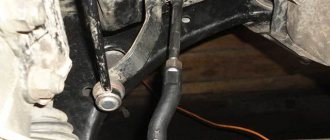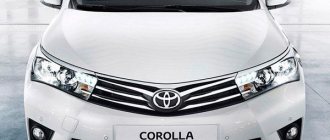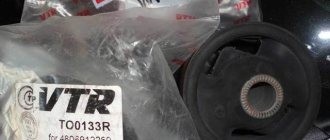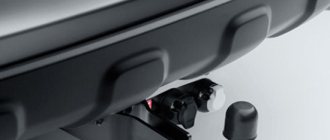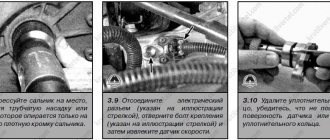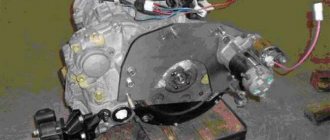Shock absorbers on the Toyota Corolla E120 and E150 will differ in size, not only between car generations, but also within a generation depending on the body type. In addition, the shock absorbers of the Corolla E120 differ from the E150 not only in rigidity and ground clearance within 5-6 cm, but also in fastening, in particular, on the E120 shock absorbers with PPD will differ in the holes for the steering tips, although the cups and supports (landing) are the same .
Structurally, the shock absorbers of the ninth and tenth generation Toyota Corolla consist of two pipes with gas-oil or oil filling. The supplier for the conveyor is Kayaba (KYB).
Front shock absorbers for Toyota Corolla E120
The front shock absorbers supplied for the ninth generation Corolla are divided into right-hand and left-hand. The original catalog number will differ depending on the body type and country of assembly of the car, but if necessary they can be interchanged. The technical characteristics of the front shock absorbers for the Toyota Corolla E120 are shown in the table: Original numbers and sizes of the front shock absorbers of the Toyota Corolla E120
| Original numbers and sizes of front shock absorbers Toyota Corolla E120 | |||||||
| vendor code | Assembly | Rod diameter, mm | Case diameter, mm | Length in compressed state, mm | Rod stroke, mm | price, rub. | |
| Left | Right | ||||||
| 4852080003 | 4851080103 | Europe+ UK (sedan, station wagon) | 22 | 51 | 336 | 184 | 6973 |
| 4851009711 | 4852009611 | 6713 | |||||
| 4852009890 | 4851009A60 | UK (hatchback) | 22 | 51 | 330 | 145 | 6271 |
Analogs of front shock absorbers for Toyota Corolla E120
When choosing to replace the original struts on a Toyota Corolla E120, you can find various options. As a rule, manufacturers offer two strut options for the front axle (depending on the country of manufacture), and the rear axle has the same shock absorbers. The most popular companies are shown in the table below. Kayaba supplies for sale struts of different series for both the front and rear axles (Excel G - standard, to replace the standard ones, Ultra SR - more rigid, for aggressive driving).
| Manufacturer | vendor code | Front left | Front right | price, rub. |
| KYB | WB | 334818 (Excel-G) 324701 (Ultra-SR) | 334817 (Excel-G) 324700 (Ultra-SR) | 3418/3386 4893/5255 |
| KYB | Japan (not for bad roads) | 333359 (Excel-G) | 333358 (Excel-G) | 5196/4990 |
| SACHS | WB Japan | 311914 312228 | 311913 312227 | 3477/3521 3037/12078 |
| Monroe* | WB Japan | E7010 | E7008 | 5919/3494 |
*According to the manufacturer Monroe, the article numbers of the sets are indicated on the axle (2 pieces in a package).
Shock absorber Toyota 4852080003
Shock absorber KYB 334818
Shock absorbers Kayaba (Kyb, Kayaba) TOYOTA (Toyota)
You can buy Kayaba shock absorbers for Toyota with the official KYB warranty in the KYBCOM store. We have been specializing in Kayaba for more than 15 years, we will help you select shock absorbers and springs for your Toyota car, and deliver them throughout Moscow or throughout Russia. You can also install shock absorbers with an extended warranty of up to three years in our Kayaba-authorized car service center. To replace standard shock absorbers, Toyota Kayaba offers shock absorbers of the Excel G series, which have an optimal combination of comfort and handling. Kayaba Gas-a-Just series monotube shock absorbers are suitable for heavy-duty vehicles. For Land Cruiser SUVs, the MonoMax series is offered. Shock absorbers for tuning Toyota suspension are the Ultra SR and AGX sports series (with adjustable stiffness). If you want to make the Toyota suspension more comfortable, then the Premium series of soft oil shock absorbers is suitable for you.| 1989 — 1995 | ||
| TOYOTA Auris | hatchback | 2007 — |
| TOYOTA Avensis I (_T22_) | sedan | 1997 — 2003 |
| TOYOTA Avensis I (_T22_) | station wagon | 1997 — 2003 |
| TOYOTA Avensis I Liftback (_T22_) | hatchback | 1997 — 2003 |
| TOYOTA Avensis II (T25) | hatchback | 2003 — |
| TOYOTA Avensis II (T25) | sedan | 2003 — |
| TOYOTA Avensis II (T25) | station wagon | 2003 — |
| TOYOTA Avensis Verso | minivan | 2001 — |
| TOYOTA Aygo | hatchback | 2005 — |
| TOYOTA Camry II (_V2_) | sedan | 1986 — 1991 |
| TOYOTA Camry II (_V2_) | station wagon | 1986 — 1991 |
| TOYOTA Camry III (_V1_) | sedan | 1991 — 1997 |
| TOYOTA Camry III (_V10) | station wagon | 1991 — 1997 |
| TOYOTA Camry IV (_V20) | sedan | 1996 — 2001 |
| TOYOTA Camry V (_V30) | sedan | 2001 — 2006 |
| TOYOTA Camry VI (XV40) | sedan | 2006 — 2011 |
| TOYOTA Carina E (_T19_) | hatchback | 1992 — 1997 |
| TOYOTA Carina E (_T19_) | sedan | 1992 — 1997 |
| TOYOTA Carina E Sportswagon (_T19_) | station wagon | 1993 — 1997 |
| TOYOTA Carina II (_T17_) | hatchback | 1987 — 1993 |
| TOYOTA Carina II (_T17_) | sedan | 1987 — 1993 |
| TOYOTA Carina II (_T17_) | station wagon | 1987 — 1992 |
| TOYOTA Celica (_T18_) | cabriolet | 1991 — 1994 |
| TOYOTA Celica (_T18_) | coupe | 1989 — 1994 |
| TOYOTA Celica (_T20_) | coupe | 1993 — 1999 |
| TOYOTA Celica (_T20_) | cabriolet | 1993 — 1999 |
| TOYOTA Celica (ZZT23_) | coupe | 1999 — |
| TOYOTA Corolla 6 (_E9_) | station wagon | 1987 — 1992 |
| TOYOTA Corolla 6 (_E9_) | hatchback | 1987 — 1992 |
| TOYOTA Corolla 6 (_E9_) | sedan | 1987 — 1993 |
| TOYOTA Corolla 6 Liftback (_E9_) | hatchback | 1987 — 1993 |
| TOYOTA Corolla 7 (_E10_) | hatchback | 1992 -1997 |
| TOYOTA Corolla 7 (_E10_) | sedan | 1992 -1997 |
| TOYOTA Corolla 7 Liftback (_E10_) | hatchback | 1992 -1997 |
| TOYOTA Corolla 7 Wagon (_E10_) | station wagon | 1992 -1997 |
| TOYOTA Corolla 8 (_E11_) | hatchback | 1997 — 2002 |
| TOYOTA Corolla 8 (_E11_) | sedan | 1997 — 2002 |
| TOYOTA Corolla 8 Liftback (_E11_) | hatchback | 1997 — 2002 |
| TOYOTA Corolla 8 Wagon (_E11_) | station wagon | 1997 — 2002 |
| TOYOTA Corolla 9 (_E12J_, _E12T_) | sedan | 2002 — |
| TOYOTA Corolla 9 (_E12J_, _E12T_) | station wagon | 2002 — |
| TOYOTA Corolla 9 (_E12U_, _E12J_) | hatchback | 2002 — |
| TOYOTA Corolla Verso II (_E12_) | minivan | 2004 — |
| TOYOTA Corolla Verso II (_E12_) | minivan | 2001 — 2003 |
| TOYOTA Hilux V (N8, N9, N10, N11) | pickup | 1988 — 1995 |
| TOYOTA Hilux VI (N14, N15, N16, N17, N19) | pickup | 1997 — 2005 |
| TOYOTA Hilux VII (KUN) | pickup | 2005 — |
| TOYOTA Land Cruiser 100 (J10) | SUV | 1998 — 2007 |
| TOYOTA Land Cruiser 120 Prado (J12) | SUV | 2002 — 2009 |
| TOYOTA Land Cruiser 150 Prado (J15) | SUV | 2009 — |
| TOYOTA Land Cruiser 200 (J20) | SUV | 2008 — |
| TOYOTA Land Cruiser 70 (J7) | SUV | 1984 — |
| TOYOTA Land Cruiser 70 Hardtop (J7) | cabriolet | 1990 — 1996 |
| TOYOTA Land Cruiser 80 (J8) | SUV | 1990 — 1997 |
| TOYOTA Land Cruiser 90 Prado (J9) | SUV | 1996 — 2002 |
| TOYOTA MR 2 (_W2_) | coupe | 1989 — 2000 |
| TOYOTA MR 2 (_W3_) | cabriolet | 2000 — |
| TOYOTA Paseo (EL54) | coupe | 1995 — 1999 |
| TOYOTA Paseo (EL54) | cabriolet | 1996 — 1999 |
| TOYOTA Picnic (_XM10) | minivan | 1996 — 2001 |
| TOYOTA Previa (ACR3_) | minivan | 2000 — |
| TOYOTA Previa (TCR1_, 2_) | minivan | 1990 — 2000 |
| TOYOTA Prius I (NHW11_) | sedan | 2000 — 2003 |
| TOYOTA Prius II (NHW20_) | hatchback | 2003 — 2009 |
| TOYOTA Prius III (ZVW30_) | hatchback | 2009 — |
| TOYOTA RAV 4 I (SXA1_) | SUV | 1994 — 2000 |
| TOYOTA RAV 4 I Cabrio (SXA1_) | cabriolet | 1997 — 2000 |
| TOYOTA RAV 4 II (XA2) | SUV | 2000 — |
| TOYOTA RAV 4 III | SUV | 2006 — 2013 |
| TOYOTA RAV 4 IV | SUV | 2013 — |
| TOYOTA Starlet (_P8_) | hatchback | 1989 — 1996 |
| TOYOTA Starlet (EP91) | hatchback | 1996 — 1999 |
| TOYOTA Supra (JZA80) | coupe | 1993 — 1998 |
| TOYOTA Supra (MA70) | coupe | 1986 — 1993 |
| TOYOTA Verso | minivan | 2009 — |
| TOYOTA Verso-S | minivan | 2010 — |
| TOYOTA Yaris Verso (NC/LP2_) | minivan | 1999 — |
| TOYOTA Yaris (P1) | hatchback | 1999 — 2005 |
| TOYOTA Yaris (XP13) | hatchback | 2011 — |
| TOYOTA Yaris (XP9) | hatchback | 2006 — 2011 |
| TOYOTA Hiace III (_H10_) | van | 1989 — 1995 |
| TOYOTA Hiace III Wagon (_H10_) | bus | 1989 — 1995 |
| TOYOTA Hiace IV (_H1_, _H2_) | van | 1995 — |
| TOYOTA Hiace IV Wagon (_H1_, _H2_) | bus | 1995 — |
| TOYOTA LiteAce (_R2__V) | van | 1992 — 1995 |
| TOYOTA LiteAce (_R2_LG) | bus | 1992 — 1995 |
| TOYOTA LiteAce (CM3_V, KM3_V) | van | 1985 — 1992 |
| TOYOTA LiteAce (CM30_G, KM30_G) | bus | 1985 — 1992 |
Rear shock absorbers for Toyota Corolla E120
Unlike the front ones, the rear pillars are not divided into left-hand and right-hand. The original article number of the spare part differs depending on the body type and type of assembly of the car. Data on sizes and catalog numbers are given in the table.
| Original numbers and dimensions of rear shock absorbers Toyota Corolla E120 | ||||||
| vendor code | Assembly | Rod diameter, mm | Case diameter, mm | Length in compressed state, mm | Rod stroke, mm | price, rub. |
| 4853080309 | Europe | 22 | 51 | 379 | 193 | 6383 |
| 4853009F20 | UK (sedan, station wagon) | 6983 | ||||
| 4853009910 | UK (hatchback) | 4683 | ||||
Analogues of the rear struts of the Toyota Corolla E120
Rear shock absorbers for the Toyota Corolla E120 have a wide range of choices; you can find various alternatives to the original shock absorbers, both by manufacturer and price category, but like the front struts, Kayaba remains the sales leader, due to its reliability and affordability.
| Manufacturer | A country | vendor code | price, rub. |
| KYB | WB | 341816 (Excel-G) | 2819 |
| KYB | Japan (not for bad roads) | 351701 (Ultra-SR) | 7827 |
| SACHS | — | 311915 | 3323 |
| Monroe | — | E1312 | 2944 |
Shock absorber Toyota 4853080309
Shock absorber KYB 341816
Rules to remember
Let's start with the first rule - these spare parts must be replaced in pairs. That is, if the right front strut fails, then you need to replace not only it, but also the left one, even if it is in good condition. This is because the car must have equal rigidity on both sides. The same applies to the rear struts - we change both, otherwise the car will not hold the road well, even after going through the wheel alignment procedure. And also replacing both parts will make your life easier, since the part that is not replaced will still fail and you will have to repeat all the procedures again.
The second rule applies to people who like to experiment. Let’s say right away that replacing the struts with new ones using different manufacturers or using struts of different stiffness (one in front, another in the back) is categorically not recommended. Your Toyota Corolla Fielder will be unstable and it will be a huge inconvenience for you to drive.
Front shock absorbers for Toyota Corolla E150
Front shock absorbers for Toyota Corolla E150 (tenth generation, 2006-2013) are divided into left-hand and right-hand according to the installation method. To find the required number, use the table below.
| Original numbers and sizes of front shock absorbers Toyota Corolla E150 | ||||||
| vendor code | Rod diameter, mm | Case diameter, mm | Length in compressed state, mm | Rod stroke, mm | price, rub. | |
| Left | Right | |||||
| 4852080201 | 4851080458 | 22 | 51 | 325 | 168 | 4727 |
Analogs of front shock absorbers for Toyota Corolla E150
Among the entire range of shock absorbers for replacement, Kayaba spare parts are the most popular. The next most polar due to the price category are shock absorbers from SACHS. The numbers of the most popular companies are given below.
| Manufacturer | Front left | Front right | price, rub. |
| KYB | 339701 | 339700 | 3864 |
| SACHS | 315012 | 315013 | 3599/3648 |
| Monroe | G8120 | G8119 | 5031/4900 |
Shock absorber Toyota 4852080201
Shock absorber KYB 339701
Rear shock absorbers for Toyota Corolla E150
The rear shock absorber struts for the Corolla E150, as well as for the E120, are not divided into left/right. Technically, the shock absorbers for the rear axle are represented by a single original article. The structural dimensions of which are indicated in the table below.
| Original numbers and dimensions of rear shock absorbers Toyota Corolla E150 | |||||
| vendor code | Rod diameter, mm | Case diameter, mm | Length in compressed state, mm | Rod stroke, mm | price, rub. |
| 4853080501 | 12,5 | 45 | 359 | 246 | 3749 |
The main reasons for the failure of car struts
Shock absorbers are suspension elements - this applies to any car. As everyone knows, the main reasons for the failure of struts is careless operation of the car. This includes the inexperience of the driver sitting behind the wheel and collecting all kinds of holes, stones and other obstacles in the way of the car, as well as the quality of domestic roads.
Gradually, shock absorbers exhaust their working life. Even if the driver is experienced, skillfully avoids obstacles, and carefully operates the car on the roads, he physically cannot avoid driving on broken domestic roads.
Over time, they begin to leak, knock on bad roads and eventually become completely unusable. Failed parts cause the car to lose control, have poor road holding when cornering, and skid easily. So, when the rack has become completely unusable, it is worth replacing. And here, when it comes to replacing the racks, it’s worth immediately understanding a few important rules.
Analogs of rear struts for Toyota Corolla E150
When replacing original struts on a Toyota Corolla E150, three main manufacturers are in greatest demand: Kayaba, Sachs, Monroe. Manufacturer numbers are given in the table.
| Manufacturer | vendor code | price, rub. |
| KYB | 344811 | 2550 |
| SACHS | 314890 | 2505 |
| Monroe | G1095 | 2170 |
Shock absorber KYB 344811
Shock absorber SACHS 314890
Which struts to choose for a Toyota Corolla?
When choosing struts for a Corolla, you need to take into account the country of manufacture of the car, and also pay attention to the series of shock absorbers (like Kayaba). The most often preferred from companies: Sachs, Kayaba, Monroe. Among the reviews from car owners, Kayaba racks are the most popular. When selecting shock absorbers, it should be taken into account that Corollas supplied to Russia are equipped with gas-oil struts designated for bad roads. The struts that are purchased in Europe are much softer and, accordingly, it is much easier to break through them, their breakdown force is less than that of native PPDs, and motorists do not recommend installing oil struts due to the short travel of the suspension, as a result of which the car sways strongly on them. In addition, the springs are installed on the car not for oil shock absorbers, so you will have to change the springs along with the shock absorbers, and this is an additional expense. It is also not recommended to install gas ones, firstly they are more expensive and secondly they have a high internal gas pressure of about 60 atm. (for gas-oil ones approximately from 5 to 20 atm). Gas ones are less common, mainly oil and gas-oil ones with the so-called gas pressure are used, they have two working elements, oil and gas, gas under pressure is needed to counteract the foaming of the oil during operation.
When you need to change struts on a Corolla E120: be on the lookout!
The car service book recommends replacing struts every 50-60,000 km or after 5 years of use. When operating a vehicle on dirt roads or problem areas, installation of new components may be required earlier - in order to reduce the likelihood of vehicle suspension failure, it is necessary to regularly inspect the struts for damage.
The main signs requiring replacement of components are:
- Traces or obvious leaks of oil;
- Presence of cracks on the glass;
- The appearance of extraneous noise during operation.
The best way to check the struts is a test drive - at low speed you need to drive the car through several sharp turns. If there are extraneous sounds or if the car rocks in different directions, the racks will have to be changed: properly functioning components should dampen the rocking of the car after the first roll towards the turn.
Note! Shock absorbers on a car must be replaced only in pairs - installation of components of different brands or models with different levels of wear is not allowed. When replacing only a damaged shock absorber, the stiffness of the vehicle's suspension is lost, as a result of which the vehicle may lose control at cruising speed or roll over when entering a turn.
It is also not recommended to buy racks of different rigidity and design solutions - the Corolla does not tolerate experiments with the body, and when replaced, the comfort and maneuverability of the vehicle will be lost. The optimal choice would be to purchase models recommended by official Toyota dealers that meet the required rigidity parameters.
